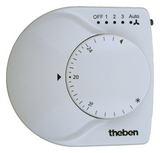The importance of saving energy has never been greater and where better a place to start than with your heating control. If you can reduce your domestic energy consumption by introducing more sophisticated heating controls then now is the time to act. HMRC have reduced the rate of VAT down to 5% for the supply and installaton of heating controls. Depending upon what type of heating you have there are a number of measures you can take to ensure that your home has the correct level of heat throughout when you need it. By putting in place proper heating controls you can ensure that you have a more evenly spread heat throughout the house when it is occupied.
HMRC Energy saving materials Notice 708/6 is where you can find the detail of what can be 5%VAT rated. New buildings of course have their own VAT rating rules (explained in Notice 708 buildings and construction), here we are focusing on what can be 5% rated under energy saving. Heating systems (including heating and hot water systems) used in residential accomodation such as a houses, blocks of flats or other dwellings that include such items as electronic timers, thermostats, mechanical or electrical valves are covered by the 5% VAT notice. HMRC go further than this and explain that the installation (material and labour) is 5% rated and also that ‘acilliary (paragraph 2.3.2) supplies’ may be included. “An ancillary supply is a supply of goods or services that is a better means of enjoying the principal supply.” Not covered under notice 708/6 – replacement boilers, complete heating systems either replacement or new, adjustment of existing controls (paragraph 2.2 “Installation, in this context, means putting in place energy saving materials. This involves some process by which materials are permanently fixed in place”).
Getting back to plain English then – If at the residence you live in (there is a list (paragraph 2.16) it includes elderley care homes, hospices, monasteries, nunneries, student accommodation, self catering holiday accommodation, caravan homes, house boats) you are looking to make energy saving by introducing enhanced means of heating and hot water control then the likelyhood is that any work undertaken by your installer will be rated at 5% – a 15% saving to the customer!
We must point out that this article is based on our experiences to date and is in no way definitive ( you could make a career out of interpreting VAT documents). Of course every case is unique and we would recommend that if you are unsure weather a particular item can or cannot be zero rated then it is always best to contact the HMRC written referrals team direct.
How can heating controls save money?
Heating controls ensure that you have heating and hot water when you need it. Conversely they are also in place to ensure that your heating and hot water systems are NOT wasting energy when no one is in the property (or in a particular part of the property).
Most domestic heating control systems ‘call for heat’ i.e they switch the boiler on which heats the water. The heating control manages how often and when the boiler is being called for heat. Once it has the hot water in the system then it also manages how the hot water is distributed to the radiators or U/F heating. With electric heating the scenario is simplified because there is no heat store when you call for heat, you are basically switching the mains electricity on.
Your heating system will have time clocks that operate the boiler and hot water demand. It will also have (at least) a single thermostat that regulates the overall temperature of the house. In most cases the home owner can readily adjust these parameters. Heating control may also encompass heating modes, typically home, night, away and frost protect. These modes usually relate to a reduction in temperature from a set point value. So you have your set point at say 18 deg C, when you leave the house the heating is set to away mode and the actual temperature value that the heating system is trying to achieve is dropped by (say) 10 deg C.
Further savings can be made by providing zoned areas for heating. Where radiators are present this is best achieved by replacing conventional manual radiator valves with thermostatic radiator valves (TRV’s), this in effect provides each radiator with an element of individual temperature control. Where U/F heating or more sophisticated systems are required a separate room thermostat can be introduced.
Of course further saving can be achieved by having a central control system that allows access to all of the system components and thus the ability to control individual modes, timers and zones centrally.
Still further and potentially greater savings can be made if we know WHEN the home is occupied – what better way to tell than when the security system is set (or unset). This is where the benefits of a home automation system come into play as it is usually relatively simple to have your security system tell your heating system that the security has been armed – i.e that the house is unoccupied and that the heating temperature can be dropped down by 10 deg C. Similar results can be achieved with night modes and holiday (frost protect) modes.
With the advent of complementary new energy producing items such as solar power, heat pumps, wind turbines, the question of control becomes ever more important (and complex). Currently most energy solutions are installed with their own seperate controller. If the heating / energy management control can be treated as a single entity then the possibility exist for far greater savings to be made.

